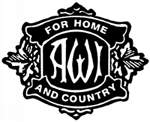Tweedsmuir Histories
The “histories” produced by the Women’s Institutes (WI) are an eclectic mix of family and local history delivered in a variety of formats, from scrapbooks to bound and published volumes. No matter what their content or form, they are a rich source of social history.
The earliest of these histories were produced in Ontario. The Federated Women’s Institutes of Ontario (FWIO) had a long-standing interest in compiling local histories as a means of preserving the accomplishments of rural society. According to historian, Linda Ambrose, the 1926 Annual Report of the Institutes Branch of the Ontario Department of Agriculture describes the production of local histories as a significant part of the WI’s commemoration of its 30th anniversary and the country’s 60th anniversary (Ambrose 76).
Ambrose writes that, in 1934, the FWIO Committee on Historical Research established a “Historical Research” Convenor who published a primer in Home and Country on how to conduct local history. In fact, the FWIO was congratulated at the 1936 Associated Country Women of the World (ACWW) conference on showing leadership in this area.
By the mid 1930s, the British WIs were also producing local “village” histories. Lady Susan Tweedsmuir, wife of the then Governor General of Canada, was interested in the work of the WI on both sides of the Atlantic. From 1936-1940, she served as honorary president of the Federated Women’s Institutes of Canada. In the late 1930’s, she had encouraged the FWIO to expand its efforts to record local history. Accordingly, in 1940, the FWIO approached Lady Tweedsmuir to recognize the historical work it had been engaged upon for nearly 20 years. As of 1940, the histories produced by the WI were to be called the Tweedsmuir History Books. Lady agreed to sponsor a competition for the best of these histories.
In 1945, guidelines for writing local histories were published in Home and Country. These Tweedsmuir histories were to include a foreword by Lady Tweedsmuir; a photograph of Lord and Lady Tweedsmuir, another of Adelaide Hoodless; several chapters on the historical background and context of the local WI; on local infrastructure such as libraries, churches and schools; and on such local events as contributions to the war effort.
In 1947, the first history prizes were awarded as part of the 50th anniversary celebrations of the FWIO. The guidelines were renewed in 1962 with a 39 page Manual for Compiling Tweedsmuir Histories, which encouraged creativity, along with careful citation. This new approach signalled a shift in focus to the scrapbook format.
Source:
Ambrose, Linda. “Ontario Women’s Institutes and the Work of Local History.” In Creating Historical Memory: English-Canadian Women and the Work of History. Eds. Beverly Boutilier and Alison Prentice. Vancouver: UBC Press, 1997.75-98.
